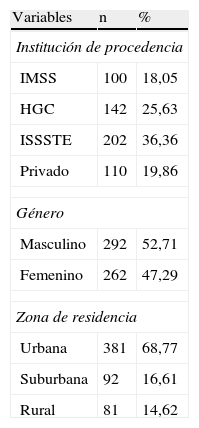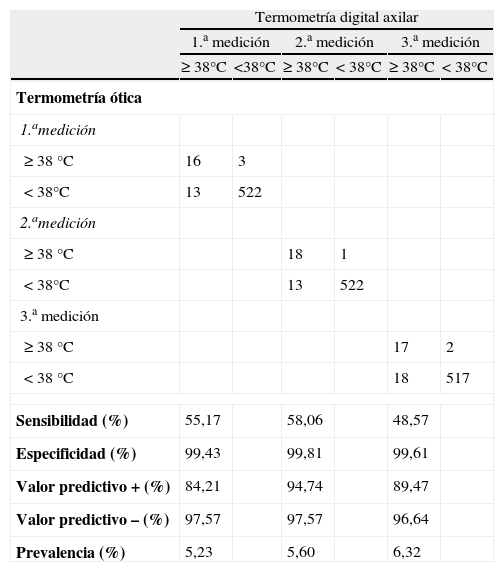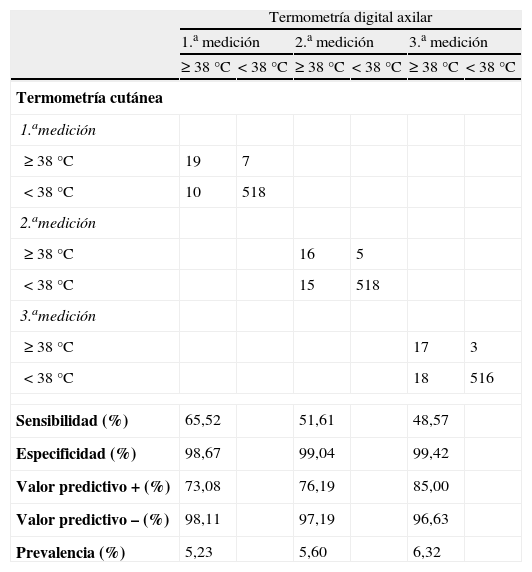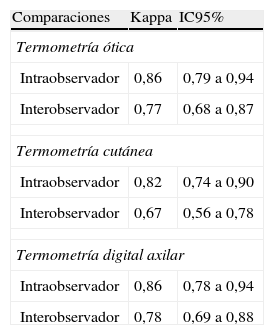comparar las mediciones de la temperatura corporal con termómetros ótico y cutáneo con termómetro digital axilar.
MétodoLos sujetos fueron niños hospitalizados o de consulta externa del Hospital General Celaya, Clínica Hospital ISSSTE y Hospital General de Zona No. 4 del IMSS y de servicio privado pediátrico en Celaya (Guanajuato) desde neonatos de un día de vida hasta adolescentes de 16 años de edad, reclutados durante un mes en cada institución, seleccionado el orden de las instituciones por método aleatorizado simple. Se midió la temperatura corporal con termómetro ótico, termómetro cutáneo y digital axilar. Todas las mediciones se tomaron en 3 ocasiones.
ResultadosLa muestra estuvo integrada por 554 niños. Entre termómetro ótico y digital axilar, la r de Pearson fue de 0,57 a 0,65, con relación lineal positiva (p<0,05); entre el cutáneo y el digital axilar, la r de Pearson fue entre 0,47 y 0,52 con relación lineal positiva (p<0,05). La kappa intraobservador para el termómetro ótico fue de 0,86, e interobservador fue de 0,77, para el termómetro cutáneo fueron 0,82 y 0,67, respectivamente y para el termómetro axilar digital fue de 0,86 para la confiabilidad intraobservador y de 0,78 para la interobservador.
ConclusiónEl termómetro ótico y el digital axilar muestran mejor precisión de la medición de la temperatura corporal que el termómetro cutáneo.
To compare body temperature measurements using tympanic, skin and digital axillary thermometers.
MethodHospitalized or outpatient children from the General Hospital Celaya, ISSSTE Hospital Clinic and General Hospital No. 4 IMSS, and the pediatric private service in Celaya, Guanajuato, from 1 day of life until 16 years old, were recruited over a one month period, after their parents signed the consent form. The order of each institution was selected by simple randomization. Body temperatures were measured in triplicate using tympanic, skin and digital axillary thermometers.
ResultsThe sample consisted of 554 children. The Pearson r between the tympanic and digital axillary thermometers was 0.57 to 0.65, with a positive linear relationship (P<.05); between the skin and the digital axillary thermometers, it was between 0.47 and 0.52 with a positive linearrelationship (P<.05). The intra-observer Kappa for the tympanic thermometer was 0.86, and for the inter-observer was 0.77; for the skin thermometer it was 0.82 and 0.67, respectively, and for the digital axillary thermometer it was 0.86 for intra-observer reliability and 0.78 for inter -observer reliability.
ConclusionTympanic and axillary thermometers showed better precision in measuring the body temperature in children than skin thermometers.
Artículo
Comprando el artículo el PDF del mismo podrá ser descargado
Precio 19,34 €
Comprar ahora












